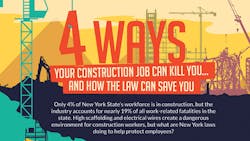4 Ways A Construction Job Can Kill You
Construction workers, although they account for a relatively small percentage of the total workforce, suffer some of the most serious injuries at rates higher than other industries. In New York state, only 4 percent of the total workforce has anything to do with construction. But 19 percent of all work-related deaths occurred in the industry, and an even higher proportion of severe injuries occurred. The top causes of construction-related fatalities are falls, struck-by an object, electrocution and caught between objects.
The federal government relies on two agencies – NIOSH and OSHA – to identify workplace dangers and conduct research, training and enforcement to ensure the safety of the country's workers. These organizations have gone a long way to promote safer job sites, but the numbers clearly suggest that more effective strategies are necessary.
According to Banville Law, New York state may be a model for the rest of the United States. New York's progressive construction laws sweep aside the restrictions of workers' compensation, which helps protect construction employees from negligent employers.
Banville Law created this infographic to provide insight into the most common work site dangers and discuss what lawmakers in New York state – often a bellweather for occupational safety and health regulations – are doing to protect construction workers.
How New York Protects Injured Construction Workers
New York's Labor Law Sections 240 and 241 lay a solid foundation of support under every construction worker in the state. Some 65 percent of all workers use scaffolding from day-to-day, climbing high to build, repair, paint, clean and demolish structures. Despite OSHA regulations and efforts by construction firms to promote safety on site, numerous workers are seriously injured in falls from elevation. Under New York's prevailing workers' compensation programs, these injured workers only would be able to claim medical expenses and lost wages.
But 240 and 241 don't let that happen. Under those labor laws, employers are held to a higher standard when it comes to scaffolds, ropes, pulleys, blocks, hangers, irons, hoists, braces and ladders. Employers are required to:
- Maintain safe elevation structures; and
- Provide precautions against falls.
When they don't take these precautions and workers are hurt, 240 and 241 allow workers to hold their employer accountable and recover additional costs over and above direct medical costs and lost-time wages.
This infographic also takes a look at other dangers on construction sites, including electrocution and building collapse.

